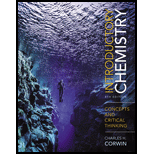
Concept explainers
(a)
Interpretation:
The balanced equation for the reaction that takes place when sulfur is heated with oxygen is to be stated.
Concept introduction:
A
(b)
Interpretation:
The balanced equation for the reaction that takes place when sulfur is heated with oxygen in the presence of
Concept introduction:
A chemical reaction is a process in which rearrangement of atoms or ions takes place between two reacting species. A balanced chemical equation represents an equation in which all the reactants and the products are written with their stoichiometric coefficient and physical states. The number of atoms of an element on both sides of the equation is equal.
Want to see the full answer?
Check out a sample textbook solution
Chapter 7 Solutions
Introductory Chemistry: Concepts and Critical Thinking (8th Edition)
- Write balanced equations for each of the following reactions. (a) When mercury(II) oxide is heated, it decomposes to form O2 and mercury metal.arrow_forwardWrite a balanced equation for each of the following decomposition reactions: (a) Solid silver hydrogen carbonate decomposes with heat to give solid silver carbonate, water, and carbon dioxide gas. (b) Solid nickel(II) hydrogen carbonate decomposes with heat to give solid nickel(II) carbonate, water,and -carbon dioxide gas.arrow_forwardWrite balanced chemical equations for the reactions used to prepare each of the following compounds from the given starting material(s). In some cases, additional reactants may be required.(a) solid ammonium nitrate from gaseous molecular nitrogen via a two-step process (first reduce the nitrogen to ammonia, then neutralize the ammonia with an appropriate acid)(b) gaseous hydrogen bromide from liquid molecular bromine via a one-step redox reaction(c) gaseous H2S from solid Zn and S via a two-step process (first a redox reaction between the starting materials, then reaction of the product with a strong acid)arrow_forward
- Write a chemical equation for each of the following chemical reactions: (a) Mercury liquid and fluorine gas react to give solid mercury(II) fluoride. (b) Zinc metal reacts with sulfuric acid to give aqueous zinc sulfate and hydrogen gas.arrow_forwardWrite a balanced equation for each of the following combination reactions. (a) Sulfur is heated with oxygen to form sulfur dioxide gas. (b) Sulfur is heated with oxygen and Pt catalyst to form -sulfur trioxide gas.arrow_forward(c) Give the formula of a fertilizer containing nitrogen and sulphur atoms and state the oxidation state of nitrogen and sulphur in the compound. Formula of fertilizer Oxidation state of Nitrogen Oxidation state of sulphurarrow_forward
- Write a balanced formula equation for each of the following. Please answer parts (a) through (h) (a) Titanium metal reatcs with selenium to produce crystals of titanium(III) selenide. (b) Phosphoric acid is neutralized with barium hydroxide to produce a precipitate of barium phosphate in water. (c) Nitrogen gas reacts with lead(II) oxide powder to yield lead(II) nitride and oxygen gas. (d) Xenon hexafluoride crystals react with water to produce xenon trioxide powder and hydrofluoric acid. (e) Aluminum carbide is reacted with water in the synthesis of methane gas. Aluminum hydroxide precipitate is also formed. (f) Plants produce the simple sugar C6H12O6 and oxygen gas from carbon dioxide and water during photosynthesis. (g) Ammonia gas (NH3) is formed along with a precipitate of magnesium hydroxide from the reaction of magnesium nitride powder with water. (h) Strong heating of copper(II) nitrate trihydrate produces copper(II) oxide, nitrogen dioxide, oxygen gas and water.arrow_forwardWhich of the following is evidence of a chemical reaction? (a) Heating baking soda releases water vapor. (b) Heating soda ash gives a flameextinguishing gas.arrow_forwardWrite a balanced chemical equation for each of the following decomposition reactions: (a) Magnesium carbonate decomposes on heating. (b) Copper(I) carbonate decomposes on heating.arrow_forward
- Write a balanced molecular equation describing each of the following chemical reactions.(c) Aqueous solutions of magnesium chloride and sodium hydroxide react to produce solid magnesium hydroxide and aqueous sodium chloride. (d) Water vapor reacts with sodium metal to produce solid sodium hydroxide and hydrogen gas.arrow_forwardWrite a balanced equation for each of the following decomposition reactions. (a) Solid chromium(III) carbonate decomposes with heat to give solid chromium(III) oxide and carbon dioxide gas. (b) Solid lead(IV) carbonate decomposes with heat to give solid lead(IV) oxide and carbon dioxide gas.arrow_forwardThe fluoride ion reacts with water to produce HF. (a) Write out the chemical equation for this reaction.arrow_forward
- Chemistry: Matter and ChangeChemistryISBN:9780078746376Author:Dinah Zike, Laurel Dingrando, Nicholas Hainen, Cheryl WistromPublisher:Glencoe/McGraw-Hill School Pub Co
 Introductory Chemistry: An Active Learning Approa...ChemistryISBN:9781305079250Author:Mark S. Cracolice, Ed PetersPublisher:Cengage Learning
Introductory Chemistry: An Active Learning Approa...ChemistryISBN:9781305079250Author:Mark S. Cracolice, Ed PetersPublisher:Cengage Learning

